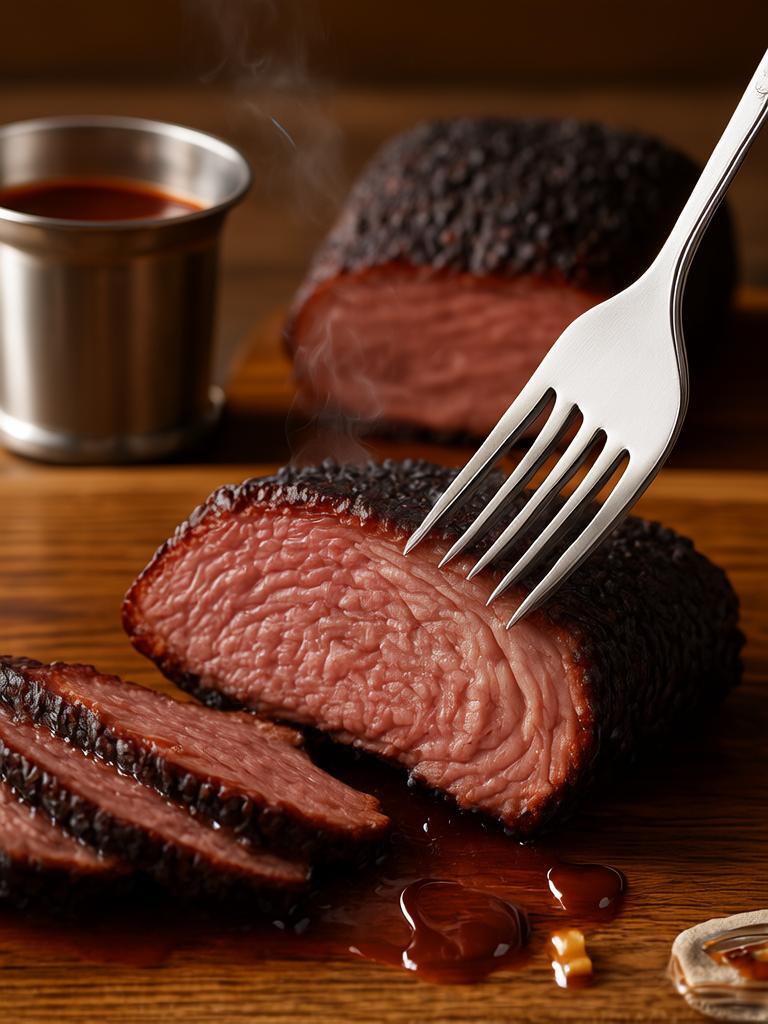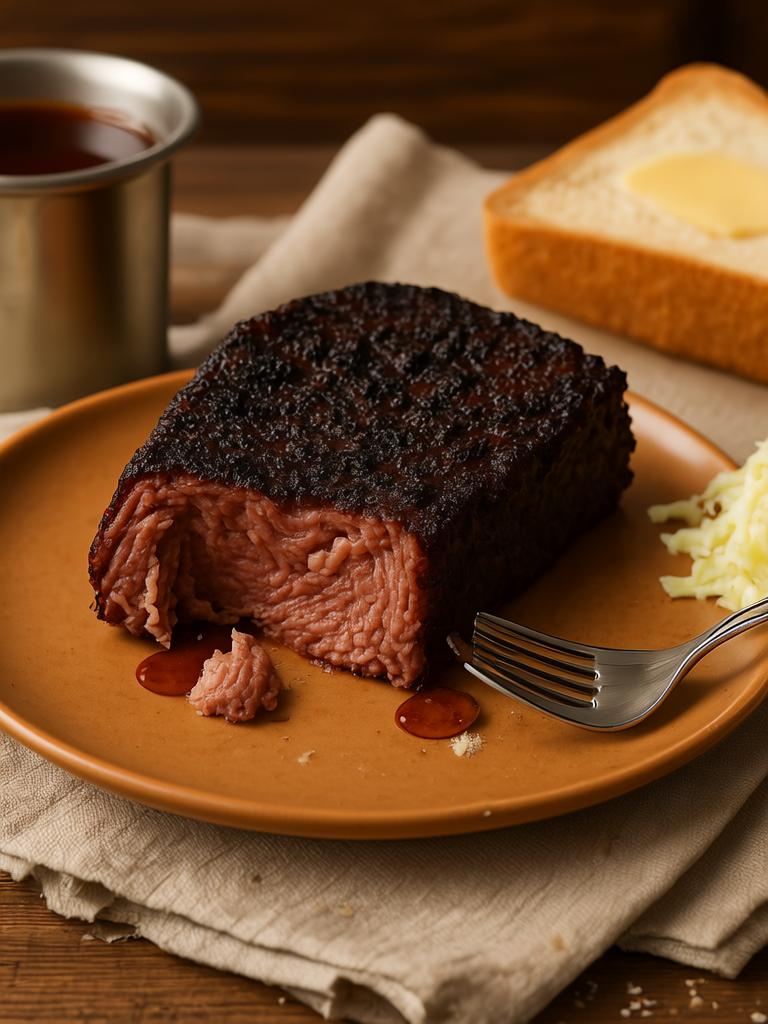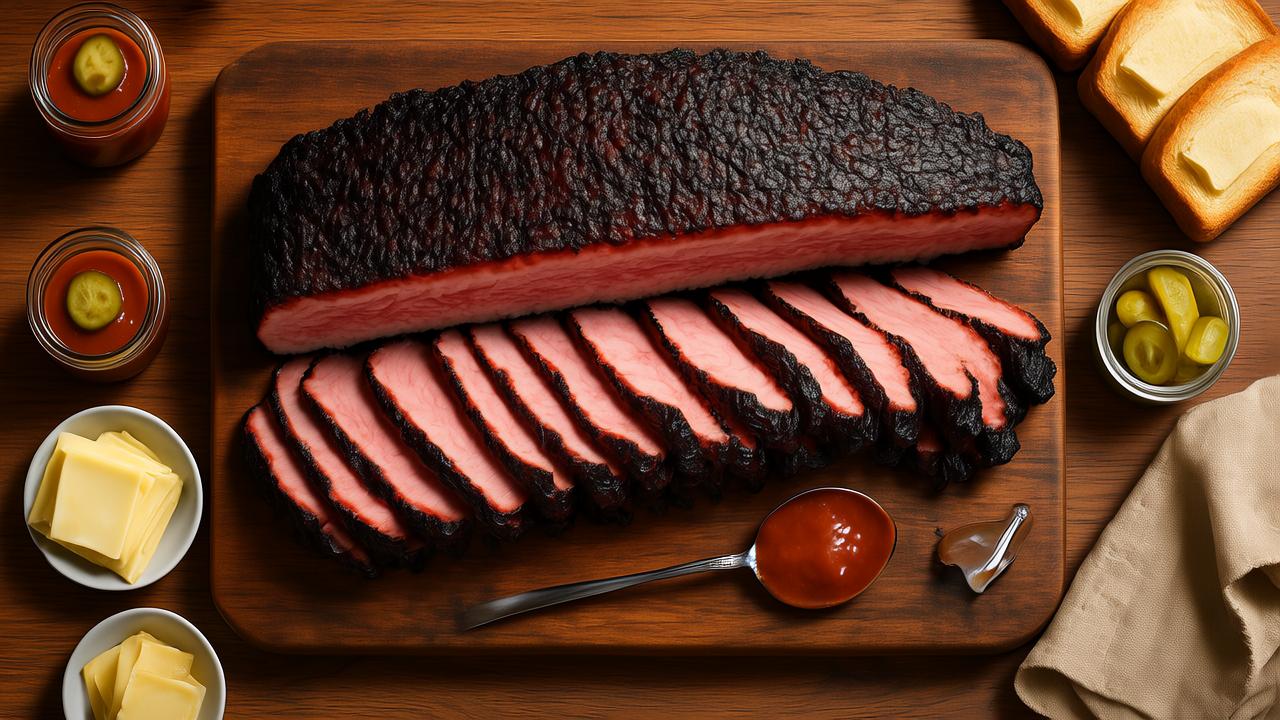Ask any pitmaster worth their salt—Texas-style smoked brisket isn’t just food, it’s almost a religion. A rite of passage. A long, slow, smokey journey that demands patience, skill, and an almost obsessive attention to detail. You mess up one little thing, and you’re left with dry shoe leather instead of melt-in-your-mouth meat. Get it right though, and it’s pure magic.
In this guide, we’re diving deep. Not just the how, but the why behind Texas brisket’s smoky greatness. Whether you’re a professional chef, an ambitious home cook, or a seasoned BBQ competitor, this isn’t some backyard blog fluff. It’s for those who want to master brisket on a real level.
Why Texas Brisket Is a Beast All Its Own
First off, let’s be clear—Texas-style brisket ain’t your grandma’s Sunday roast. We’re talkin’ about a slow-smoked, dry-rubbed, bark-covered slab of beef that’s kissed by fire and smoke for 10, 12, even 18 hours.
There’s no sauce slathered on it. No sugar hiding in the rub. No shortcuts. Texans believe in beef. Salt. Pepper. Smoke. And time.
This style came from German and Czech immigrants who settled in Central Texas and brought their butchering skills with them. They cooked tough cuts low and slow, letting smoke and time transform them. Today, it’s the gold standard of barbecue.
The Cut: Know Your Brisket Inside Out
You’re not just grabbing any hunk of beef. Brisket is the primal cut from the lower chest of the cow. It’s a working muscle—tough as a tire at first. But full of flavor if you handle it right.
Now, here’s the deal: brisket comes in two parts—the flat and the point. The flat is leaner, more uniform, slices pretty. The point is fatty, juicy, full of marbling, but it’s wonky in shape and harder to cook evenly.
Buy whole packer briskets if you’re serious. Not trimmed, not chopped. 12 to 16 pounds. USDA Prime if your wallet allows. That marbling will help later, big time.
Prep: Trim Like You Mean It
This part’s not sexy, but it makes or breaks the cook. Too much fat, and smoke won’t penetrate. Too little, and the brisket dries out before it hits the stall.
You want about 1/4 inch fat cap on top. Just enough to render slowly and keep things juicy. Remove the hard deckle fat—it ain’t gonna render, no matter how long you smoke it.
Square off the edges so it cooks evenly. Round off sharp corners. The brisket should look aerodynamic when you’re done. Like it’s ready to fly into the smoker.
The Rub: Keep It Stupid Simple
Don’t overthink it. This ain’t competition barbecue with 17-ingredient rubs. Texas brisket uses a classic 50/50 mix of kosher salt and coarse black pepper. Sometimes a little garlic powder, maybe a pinch of paprika for color—but really, just salt and pepper.
Why? Because great brisket doesn’t hide. It doesn’t need candy coatings or sugar crusts. Let the smoke and beef shine through.
Pro tip: use 16-mesh black pepper. That’s the grind size you want. Not powdery. Not pebble-sized. Just right for bark formation.
The Smoke: Low, Slow, and Holy Smokes
Here’s where folks get twitchy. Should you cook at 225°F? 250°F? What wood? How long? Water pan or not?
The general sweet spot is 250°F. Some go lower, some higher, but that temp gives good smoke absorption, steady bark formation, and won’t drag on forever.
Stick burners are king in Texas. Offset smokers with post oak wood. Oak burns clean, smells amazing, and gives a mild, balanced smoke flavor. You can use hickory or pecan too, but avoid mesquite unless you like your brisket to taste like a campfire.
Don’t use green wood or wood chips soaked in water—that’s amateur hour. Use seasoned, dry splits. And get that blue smoke. Not white. Not black. Blue-ish, almost invisible smoke is clean smoke. That’s what you want.

The Stall: Where Dreams Go to Die (or Not)
About 4 to 6 hours in, your brisket will hit the dreaded stall. It’ll hover around 160°F. Feels like forever. That’s the evaporative cooling effect—moisture from the meat is cooling the surface as fast as your heat is rising.
Don’t panic. You’ve got two options:
- Let it ride. True traditionalists go naked all the way, letting bark build slowly and pushing through the stall naturally. Takes longer.
- Texas Crutch. Wrap it in butcher paper (preferred) or foil once it hits 160–170°F. This traps moisture, pushes it through the stall faster, and retains more juice. Butcher paper lets it breathe, so you still get bark.
Both ways work. Depends on your style. Aaron Franklin? He wraps. Many pros do.
The Finish Line: Don’t Rush It, Ever
Pull your brisket when the internal temp in the point hits about 200°F to 205°F. But don’t just go by temp—poke it. It should feel like butter under your thermometer. No resistance. Wiggle the probe like a loose tooth.
Some go by the “probe test” alone. That’s honestly the better way. Every brisket’s a snowflake. One may be done at 198°F, another at 207°F. Trust your hands more than your numbers.
Resting: The Secret Sauce Nobody Talks About
Brisket ain’t ready straight off the pit. Nope. You gotta let it rest. Ideally for at least 1 hour, but 2 to 4 hours is better.
Wrap it tight, place it in a cooler or cambro, and let it equalize. The juices redistribute. The bark firms up. The collagen settles. Slice it too soon, and it’s a flood of dry sadness.
Ever been to Franklin Barbecue in Austin? That line you wait in? It’s not just for hype—they’re resting those briskets properly before slicing.
Slicing: With the Grain? Nope—Against. Always.
This part’s emotional for me, because I’ve seen too many good briskets butchered at the end.
Slice against the grain. Always. Start from the flat end and go toward the point. When you reach the end of the flat and the grain changes, rotate the brisket 90 degrees and keep slicing.
Use a proper slicing knife. Long, sharp, no serrated junk. Each slice should be about the width of a pencil. Too thin, it falls apart. Too thick, it’s chewy.
Don’t you dare chop it. That’s for sandwiches, not showcase brisket.
What Makes It Texas Brisket, Not Just Smoked Meat
It’s the bark. The smoke ring. The simplicity. The sacred balance between fat and lean, crisp bark and juicy core. The way it pulls slightly when you hold a slice. The snap, not crumble.
Texas brisket is beef in its most primal, honest form. It’s rustic. Rugged. Not dressed up in sauces and spices. And that’s what makes it hard—and glorious—to get right.
Data Point: Time vs. Temp Research (Yeah, Let’s Get Nerdy)
In a 2021 experiment by the Meat Science Lab at Texas A&M, briskets cooked at 225°F reached collagen gelatinization around 190°F internal—but only after 12.5 hours. At 275°F, the same process completed in 7.9 hours but had reduced bark integrity and slightly less moisture retention.
Translation? Low and slow builds better bark and texture, but takes longer. High and fast gets you dinner sooner, but maybe not glory.
You choose your battle.
Emerging Trends: Wagyu, Sous Vide, and Pellet Pushers
There’s a new wave of brisket cooks out there. They’re experimenting. Wagyu brisket—insanely marbled, rich, buttery—costs a fortune but delivers unreal tenderness.
Some folks sous vide brisket at 155°F for 36 hours, then smoke for 3 hours just for bark. Kinda sacrilege in Texas, but undeniably effective.
Pellet smokers like Traeger are democratizing the process, too. They’re not traditional, but they keep temp steady and let newbies play ball. Purists scoff, but hey—if it tastes good, it is good.
Common Mistakes That’ll Ruin Your Brisket
- Rushing the cook. Don’t try to speed this up. Brisket ain’t steak.
- Not trimming properly. Fat caps too thick = greasy. Too thin = dry.
- Opening the smoker too much. “If you’re lookin’, you ain’t cookin’.”
- Slicing the wrong way. Seriously—learn the grain.
Takeaways: The Brisket Gospel
- Start with a quality whole packer brisket.
- Trim smart. Rub simple.
- Smoke with clean post oak at 250°F.
- Wrap at the stall if you want.
- Pull when probe-tender.
- Rest like your life depends on it.
- Slice against the grain. Every time.

Final Word from a Smoke-Soaked Soul
Brisket will humble you. Even after 100 cooks. It’s got attitude. It pushes back. Sometimes it’s dry. Sometimes it’s perfect. You learn a little more each time you light the fire.
But when you slice into a brisket that jiggles just right, bark crunching under the blade, smoke ring blushing pink—it’s church. It’s Texas. And you’ll chase that high again and again.
Now go light that fire. And treat the cow right. She earned it.
FAQs
What is Texas-style smoked brisket?
A slow-cooked, dry-rubbed beef brisket smoked over wood, typically post oak, using just salt, pepper, smoke, and time.
What cut of meat is used for Texas brisket?
A whole packer brisket, which includes both the flat and point muscles.
What temperature should I smoke brisket at?
Around 250°F is ideal for balanced cook time, bark formation, and smoke absorption.
How long does it take to smoke a brisket?
Anywhere from 10 to 18 hours, depending on size, temperature, and cooking method.
What’s the Texas crutch?
Wrapping brisket in butcher paper or foil around 160–170°F to speed up the cook and retain moisture.
When is brisket done?
When the internal temp is about 200–205°F and it probes like soft butter with no resistance.
Should I rest brisket after cooking?
Yes—rest it for 1 to 4 hours wrapped in a cooler or warm oven to let juices redistribute.
How do I slice brisket correctly?
Always slice against the grain for tender, even bites.
What wood should I use for smoking Texas brisket?
Post oak is the traditional favorite; hickory or pecan are good backups.
Can I use a pellet smoker for Texas-style brisket?
Yes, though it’s less traditional, pellet smokers offer great control for consistent results.
Should I use sauce on Texas brisket?
Nope—classic Texas brisket stands on its own with just salt, pepper, and smoke.
What causes the brisket stall?
Evaporation from the meat cools it down, stalling the internal temp around 160°F.
What makes the bark on brisket?
A mix of rub, smoke, fat, and heat over time creates that deep, crunchy bark.
Why is marbling important in brisket?
More marbling means more intramuscular fat, which keeps the meat juicy and flavorful during long cooks.
Is wrapping brisket in foil or butcher paper better?
Butcher paper is preferred for breathability and better bark; foil traps more moisture but softens bark.

Mariana is a passionate home cook who creates delicious, easy-to-follow recipes for busy people. From energizing breakfasts to satisfying dinners and indulgent desserts, her dishes are designed to fuel both your body and hustle.
When she’s not in the kitchen, she’s exploring new flavors and dreaming up her next recipe to share with the Foodie Hustle community.

